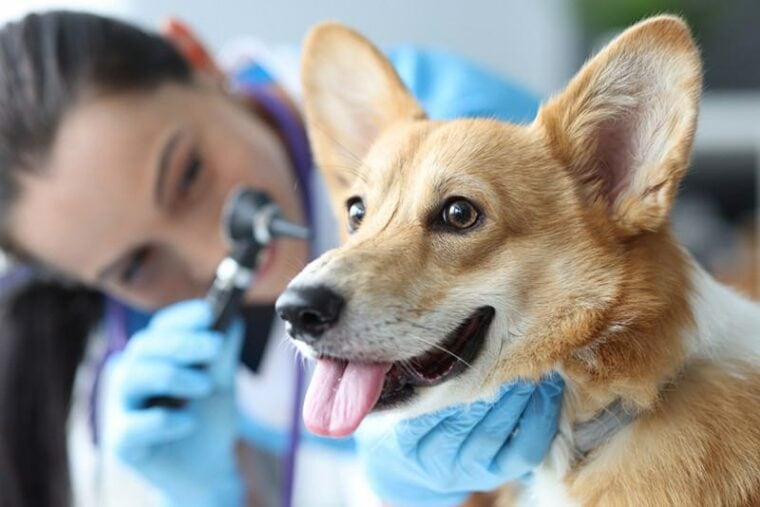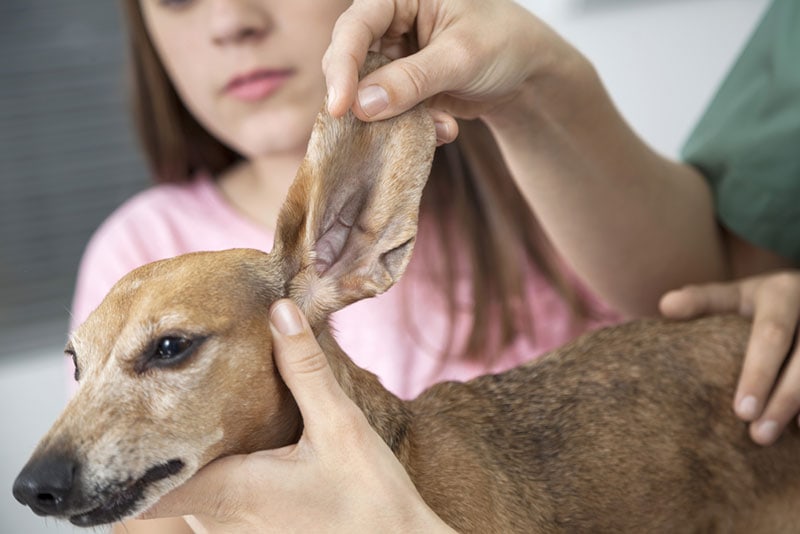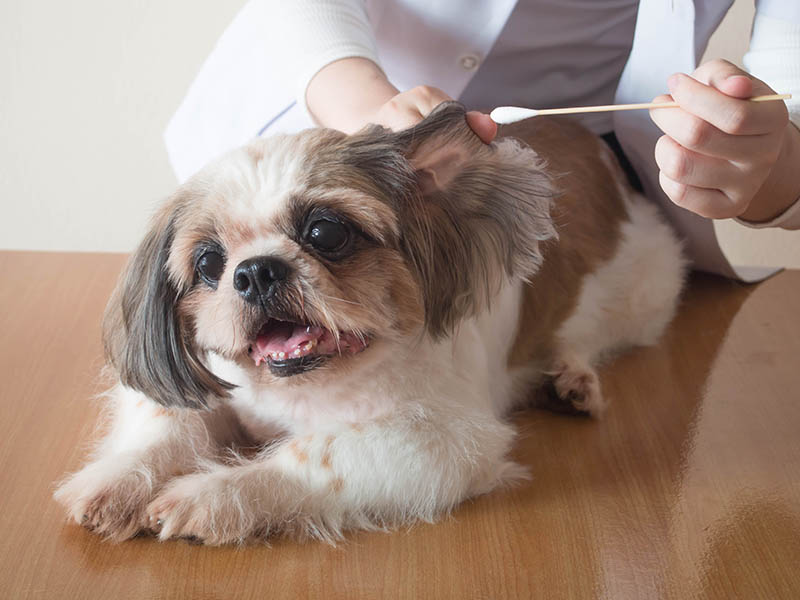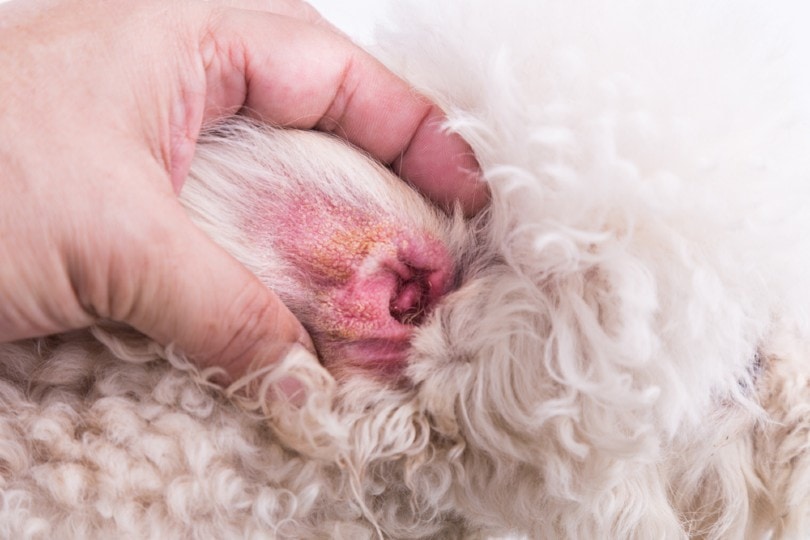
Click to Skip Ahead
Is Fido not responding to your calls? Is Fluffy easily startled when you pet them? These are a few signs of hearing loss that owners often note in their dogs. Hearing loss can be temporary, or it can be permanent, depending on the cause. Additionally, hearing loss may only affect one ear, or it may be bilateral. Diminished hearing in companion dogs may be difficult for owners to adjust to; however, dogs tend to live full lives despite the loss of this sense. Below are some of the most common reasons for hearing loss in dogs.
The 6 Causes of Hearing Loss in Dogs
1. External Ear Infections
Dogs suffering from ear infections can experience hearing loss for several reasons. First, dogs may be quietly battling an ear infection prior to the owners being alerted to the problem. During the infection, excessive amounts of discharge are formed in the ears, and the canals become narrowed due to inflammation. Inflammation and debris act to physically obstruct the transmission of sound from the environment down toward the middle and inner ear, leading to hearing impairment.

2. Middle and Inner Ear Infections
The external ear canal is separated from the middle ear by a thin membrane called the tympanum. The tympanum can rupture due to infection, trauma like a foreign body, or even through flushing of the ears.
When the tympanic membrane is ruptured, infectious agents may make their way to the middle and inner ear causing inflammation. If inflammation occurs in the middle or inner ear, hearing loss is often noted. Additional signs that may be noted include pain when chewing, shaking of the head, abnormalities with nerves innervating the face, and ataxia. This type of hearing loss can often be restored once the underlying cause of inflammation has been resolved.
3. Ototoxicity
There are medications that can be applied topically to treat ear infections that may cause hearing loss in dogs if the drug enters the inner ear where sound is processed. Drugs applied to the external canal can enter the middle ear through a ruptured tympanic membrane, then can permeate into the inner ear causing damage to structures.
It is important to carefully read the dosing instructions before applying medications, as overdosing may increase the chances of ototoxicity. Alternatively, there are medications that can be given orally or that are given via injection that can affect the inner ear through blood absorption and spread.
If you feel like your dog is experiencing hearing loss, you should discontinue the medication and schedule an appointment with your veterinarian as soon as possible. Your veterinarian will likely thoroughly rinse your pet’s ears with saline and closely evaluate the ear canal. Hearing loss from ototoxicity is often permanent.

4. Age
The most common type of acquired hearing loss in dogs is called Presbycusis or Age-Related Hearing Loss (ARHL). The exact mechanism of hearing loss is unknown, but it is likely multifactorial. First, hearing loss may only be noted with certain tones or pitches and may not be obvious. Hearing loss can begin in dogs between the ages of 8–10 years of age. Unfortunately, there is no treatment for ARHL, and hearing loss is progressive.
5. Growths and Foreign Bodies
Growths can occur in the ear canal leading to a blockage in the transmission of sound from the environment to the inner ear. Foreign bodies can act similarly. Both foreign bodies and tumors can also lead to middle and inner ear trauma, further exacerbating the loss of hearing.
Dogs with growths in the middle or inner ear may experience other neurologic signs in addition to loss of hearing, including ataxia and head tilt. Growths and foreign bodies should be removed, and depending on the location, hearing will often be restored.

6. Hereditary Deafness
There are some breeds of dogs more likely to have hearing loss due to genetics. Examples of breeds that often experience hereditary deafness include the Dalmatian and Australian Shepherd. Dogs that are prone to deafness typically have white or merle coloration to their fur and blue eyes. The inability to hear is associated with the alterations of melanocytes which leads to nerve degeneration.
There is another type of deafness that dogs can experience that occurs soon after birth and has no association with coat pigmentation, but instead has to do with changes to the hairs of the cochlea. Hereditary hearing loss is typically congenital, meaning hearing loss is noted soon after birth. Dogs that may be predisposed to hereditary deafness can have a BAER test done to check hearing.
Signs of Hearing Loss in Dogs
Can Hearing Loss Be Restored?
Unfortunately, hearing may not be restored in all patients experiencing hearing loss. It is necessary to identify the underlying cause of hearing loss so that it can be appropriately addressed.
Dogs with ear infections have a good chance of regaining their hearing once the infection has resolved, and secondary trauma like a ruptured eardrum has healed. Dogs with tumors or foreign bodies responsible for obstructing the ear canal may also experience resolution once the obstruction has been removed.
Unfortunately, dogs that are born deaf and elderly dogs with suspected age-related hearing loss will not have improvements in their hearing.
Living With a Dog With Hearing Loss
It is helpful to teach hand signs along with verbal commands while hearing is intact as a preventative measure. This establishes a way of communication regardless of hearing capabilities. If hearing loss has occurred before hand signs have been formed, that is okay! Dogs are quick learners, so it’s not too late to teach them.
It is important to try not to startle your pet. Stomping hard or patting the floor can alert your pet to your presence through vibrations. Flicking the lights on and off may also help gain your pet’s attention. It is very important to educate young members of the household who may not be as dog-savvy on the importance of avoiding startling a dog with hearing loss. A startled dog has an increased risk of being reactive!
And finally, dogs that have lost the ability to hear well will be less aware of certain dangers, like automobiles. It is important to safely restrain your pet whether with a fence or on a leash to minimize the risk of injury.

In Summary
As soon as signs of hearing loss are noted in your companion, an appointment should be scheduled with a veterinarian to have the ears closely evaluated. It is important to identify the underlying cause of hearing loss so that appropriate interventions and treatment can be implemented. Unfortunately, not every cause of hearing loss can be corrected. Dogs with hearing loss can still live full lives with the support of their human counterparts.
Featured Image Credit: megaflopp, Shutterstock








